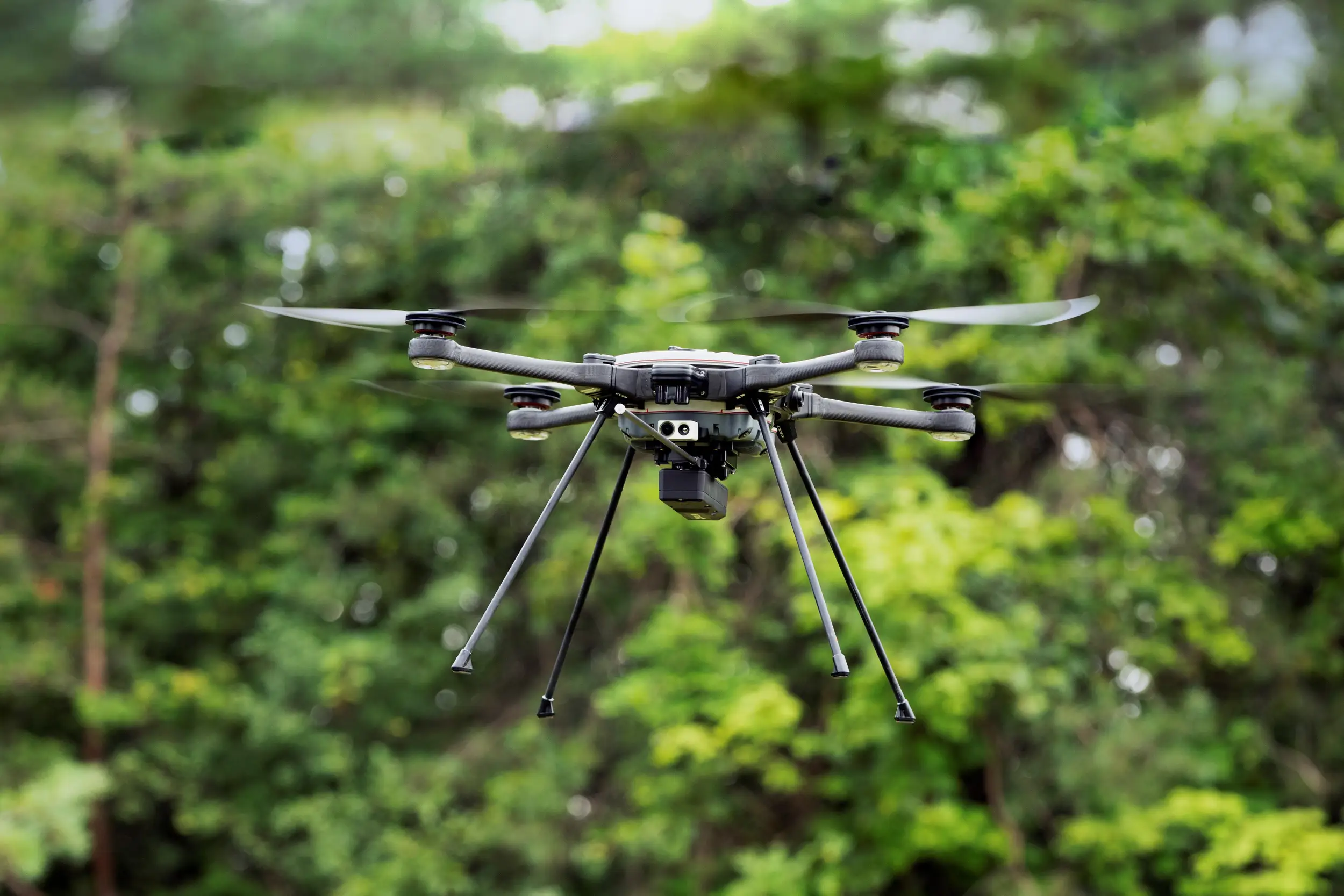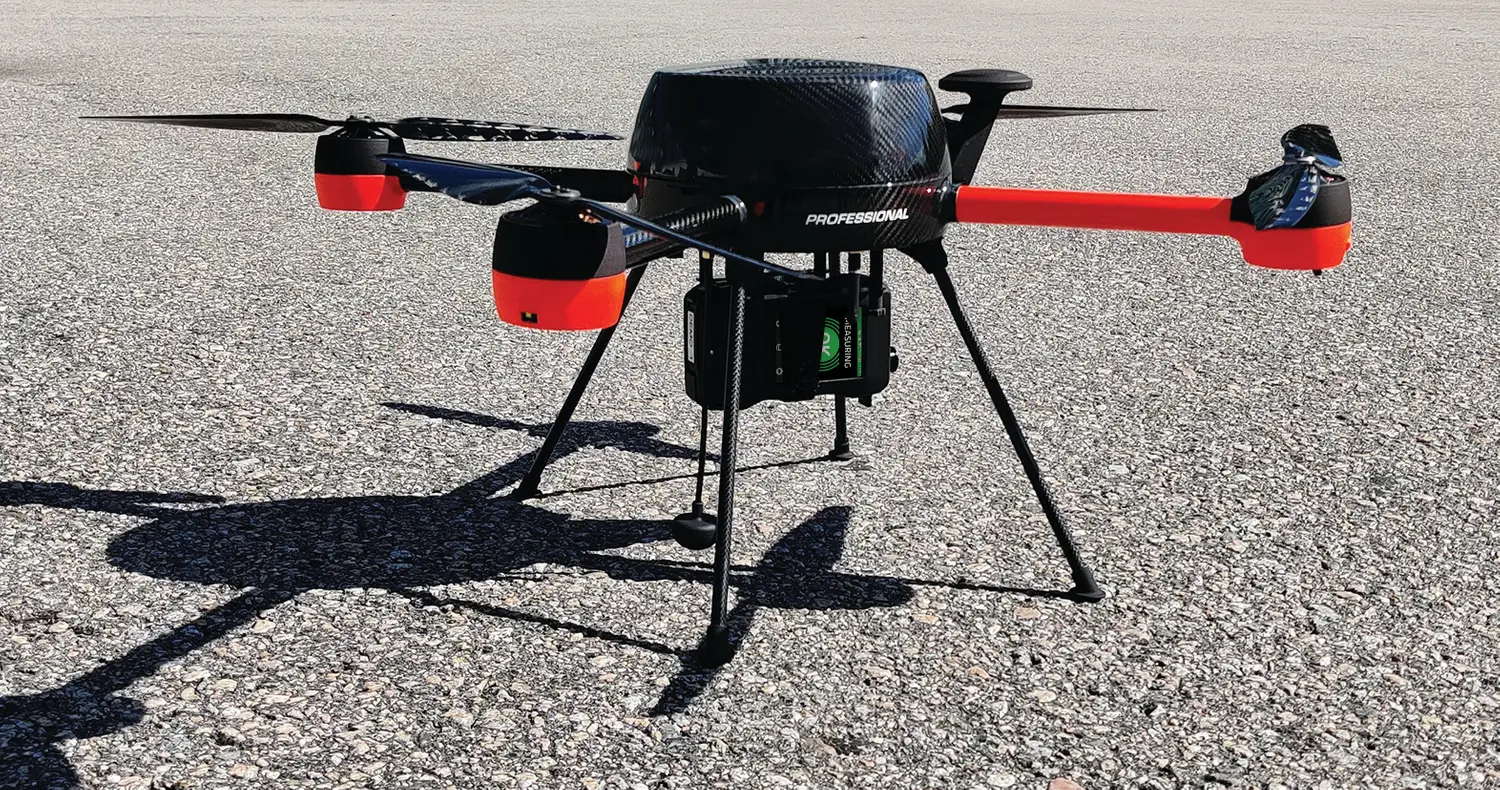
REPORT HOME > Hidden dangers
November 2023 | technology report | UAS
Detection of chemical, biological, radiological and nuclear threats is an inherently dangerous task, often still carried out by dismounted troops using handheld devices. Advances in drone-borne sensors and greater autonomy for uncrewed aircraft is beginning to relieve this risky burden, however.
Above: Teledyne FLIR Defense provides chemical, radiological and biological sensing through a range of UAS-based payloads, including its MUVE C360 multi-gas detector, pictured here. (Photo: Teledyne FLIR)
UAS can provide significant advantages in chemical, biological, radiological and nuclear (CBRN) sensing activities, enabling operators to maintain a safe distance while performing their mission.
Indeed, the potential for UAS in CBRN detection is a major focus for the US DoD. Kelly Flynn, spokesperson at the department, noted that the US National Defense Strategy, Countering Weapons of Mass Destruction Strategy and Biodefense Posture Review all ‘establish that the Joint Force must be able to prevail in CBRN environments’. This requires better integrating CBRN defence capabilities into that force, Flynn noted.
Out of harm’s way
In terms of concrete actions, Deputy Secretary of Defense Kathleen Hicks has announced the Replicator Initiative, which aims to field thousands of attritable autonomous systems over the next 18 to 24 months. Hicks said these could be ‘packed with sensors aplenty, enough to give us new, reliable sources of information in near-real time’.
These would help to keep service personnel out of harm’s way and reduce the logistics burden of carrying separate systems for CBRN detection, Flynn noted.
Another DoD effort is the CBRN Sensor Integration on Robotic Platforms (CSIRP) programme, which aims to repackage mature government and commercial CBRN sensors to mount them on uncrewed and robotic systems, including UAS.
CSIRP, part of the Pentagon’s Chemical and Biological Defense Program (CBDP), is also developing common mounting interfaces and processor hardware and software, Flynn said.
‘Although we are already using mature CBRN detection systems, the department is making science and technology investments to reduce the size/weight/power requirements and costs of the CBRN detection sensors, as well as exploiting advances in artificial intelligence, machine learning and autonomy, sensing and communication capabilities to enable even more timely and accurate detection, warning and reporting of CBRN hazards,’ Flynn added.
There are a range of companies active in this space. For example, Teledyne FLIR Defense provides chemical, radiological and biological sensing through its MUVE C360 (multi-gas), MUVE R430 (radiological spectroscopic) and MUVE B330 (biological) sensor payloads. These have been designed for integration into multiple UAS, including the company’s SkyRaider and SkyRanger platforms.
UAS have become more accessible over the past decade across varying classes of performance, mission and cost options, noted Kristin Korte, senior director, integrated detection systems at Teledyne FLIR Defense. There has also been a parallel growth trajectory in payloads to support the rapid adoption of uncrewed platforms in supporting surveillance missions, she added.
‘CBRN sensors need to concurrently evolve to accommodate integration into these platforms, including options for modular sensing to optimise not only for detection needs but also power and communications requirements,’ Korte said.
The primary objective with CBRN sensing is to maximise the sensor’s capability to perform the mission while preserving the lives of the operators conducting their jobs, she noted. Because proximity to a threat source typically improves detection performance, integration of sensing devices like the MUVE range supports the operator’s ability to conduct detection and improves the likelihood of mission success.
‘They offer operators an improved field of view for assessing situational awareness through real-time sensing within an expanded physical arena across air domains previously unobtainable by operators on the ground without highly complex, expensive standalone detection sensors,’ she added.
No sensor or associated technology is ideal for all missions, Korte noted. Adapting COTS CBRN products to support systems on the move in drones can lead to operational challenges with fundamental mismatches in product fit.
‘Is it the right size, weight and power? Can it work well for the intended mission? Can it relay useful data in a meaningful way? Trade-offs often need to occur to just permit the operator to have capabilities in some regard.’
Teledyne FLIR designed its MUVE series with ‘swappable interfaces and integration options across unmanned platforms to make it easier for our operators, or other third parties, to support their mission needs’, she added.
Avoiding exposure
Bertin Environics meanwhile manufactures chemical and radiation detection solutions for integration into UAVs and UGVs. Its ChemProX handheld chemical detector has inbuilt power and wireless data transmission capability, meaning it can be used to expand the detection capability of UAS in a quick and simple manner, said Mika Saarinen, the company’s product manager for handheld chemical detectors.
Above: The ChemProX detector from Bertin Environics, originally designed for handheld use, can be now mounted onto UAVs. (Photo: Bertin Environics)
The most obvious advantage of UAS in CBRN detection is the fact that operators do not need to expose themselves to a potential threat, Saarinen said. At a broader level, the ability to gather and receive information downrange not only helps in detecting threats, but in forming the ‘bigger picture’ of the incident more quickly, he noted.
‘As time is of the essence, being able to define this bigger picture faster and focus efforts on necessary things or areas, can help in making decisions quicker, and eventually save more lives,’ he added.
Using UAS and other uncrewed systems in CBRN detection can dramatically cut the time needed to achieve situational awareness, Saarinen said. ‘Instead of taking the time to wear the full protection suit, the first detection of the incident can be done remotely with a UAV or UGV. Combining the information from video or thermal cameras with the CBRN detectors will provide a much wider perspective of the incident, its potential chemical characteristics, etc.’
Saarinen said the capability of CBRN detectors has continued to develop, but that he has seen greater progress in the user experience. Many of these devices are still based on same core technology developed for decades, he said.
‘I have seen more development in the usability of CBRN detectors; this includes adding capabilities or solutions, such as wireless data transmission, to the already existing detection technologies to expand their capabilities,’ he said.
‘In a way, one could say that manufacturers today are thinking more outside the box. What are the capabilities or functionalities that could be added to support the core CBRN detection technology?’
The greatest challenge is not on the detection side or in the unpredictable nature of a contaminated environment, but in a potential lack of simplicity, Saarinen argued. The UAS and the work related to integrating CBRN detection capability to a platform should not be a burden to operators, he warned.
‘The technology used in different missions or platforms should aim to be simple and easy – something that is not only simple to deploy and use but also easy to understand. While CBRN detectors can offer a lot of different data and values, in most cases the core information is enough, and that information should be as easily accessed and interpreted as possible.’
Many operators may not have enough experience of using the systems in CBRN environments, he noted. ‘While the awareness is surely increasing over time, the technology itself must support the easy learning and implementation of UAS solutions in CBRN detection.’
Information sharing
For its part, Draper develops intelligent software architecture for a range of autonomous systems, and has equipped a range of small UAS for use in CBRN reconnaissance and other ISR missions. Its work has been partly funded through the US Joint Program Executive Office for Chemical, Biological, Radiological and Nuclear Defense (JPEO CBRND), a component of the DoD’s CBDP.
Above: Draper has developed new capabilities for small UAS to improve situational awareness and threat detection for soldiers. (Photo: Draper)
Draper has produced an All-Domain Execution and Planning Technology (ADEPT) software architecture that manages the performance of the entire UAS, said Camila Francolin, the company’s division leader for autonomy, guidance, navigation and control. This aims to overcome challenges with using UAS for CBRN detection.
‘Soldiers operating in urban environments need a UAS that can navigate in and around buildings and obstacles, such as trees or vehicles, even when GPS signals are degraded or completely unavailable,’ Francolin explained. ‘Soldiers dispersed across an area need a way to share information that is secure, networked and mapped to the environment.’
Over the past decade, UAS technology has evolved to become more modular, reuseable and open to enhancement by third-party users, she said. This can make it easier to add new capabilities to detect objects of interest in an area.
Other enhancements include sensor fusion algorithms, Francolin added, which enable UAS to synthesise data from instruments including GPS, LIDAR or cameras. The user interface is a critical element, with Draper using the Tactical Assault Kit (TAK) situational awareness solution, which it helped to develop as part of an Air Force Research Laboratory team.
‘A UAS with a CBRN sensor and TAK plugin can communicate with human operators and central command through a map-based common operating picture on a shared network,’ she noted. ‘Map-based interfaces, like TAK, provide a real-time, geo-referenced view of ongoing operations, and enhance decision support.’
Looking forward, Francolin expects to see remote CBRN detection using autonomous teaming drones. ‘UAS developers will be able to integrate flight software and sensor-driven algorithms so that teams of UAS can autonomously conduct CBRN missions currently performed by a single UAS, or in environments where one or more inputs are unavailable or unreliable, such as areas without GPS, zones where GPS may be spoofed and zero-light environments,’ she said.
Such teams of autonomous drones must be controlled through a single interface, which will require careful attention to and management of UAVs and sensor data to ensure the user is not overloaded with information.
‘A third trend will be collaborative behaviours within teams of autonomous aerial, ground and maritime [platforms]. The technology will enable decentralised task allocation and task prioritisation, collaborative navigation and mapping, path deconfliction and crash prevention, and team planning, control, monitoring and networking,’ she said.
Nothing epitomises the oft-cited rationale for deployment of military uncrewed systems of handling ‘dull, dirty and dangerous’ tasks more than detection of CBRN threats. While it may not yet be time for armed forces to mothball their hazmat suits, new sensors and more advanced autonomy will mean that UAS will bear an increasingly greater share of the burden and risk going forward.


